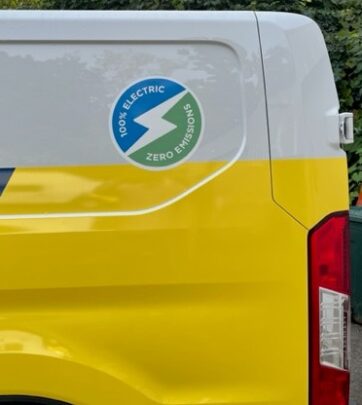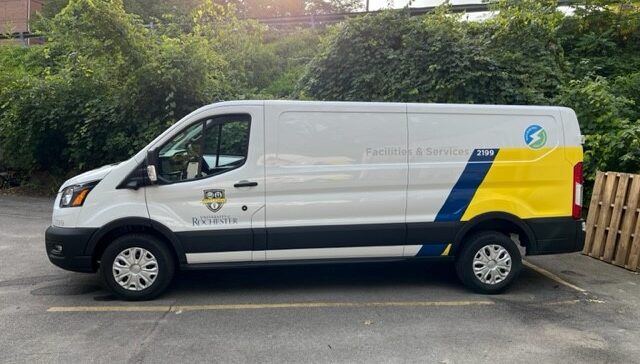Institutions of all sizes are changing the way their transportation systems are fueled and the University is no exception. The first fully-electric fleet of vehicles has been installed for use by University Facilities and Services and adds to the ways the University reduces its transportation greenhouse gas emissions.
New electric vans
 This September, University Facilities & Services added four fully electric vans to their fleet in an effort to reduce greenhouse gas emissions and save on fuel. Merritt Woodward, Fleet Services manager, oversaw the implementation of this electric vehicle (EV) fleet. According to Woodward, installing the University’s first EVs in Facilities was the perfect choice, as River Campus vans rarely venture off campus. The fleet consists of two smaller vans and two larger ones, to be used depending on need.
This September, University Facilities & Services added four fully electric vans to their fleet in an effort to reduce greenhouse gas emissions and save on fuel. Merritt Woodward, Fleet Services manager, oversaw the implementation of this electric vehicle (EV) fleet. According to Woodward, installing the University’s first EVs in Facilities was the perfect choice, as River Campus vans rarely venture off campus. The fleet consists of two smaller vans and two larger ones, to be used depending on need.
The new EVs are accompanied by three new charging stations for use by Facilities, located at the Public Safety building, Gavett Hall and the third is being installed at the Rush Rhees loading dock. These charging stations will all be from ChargePoint, the same vendor the Department of Transportation and Logistics uses for charging stations that are open to the public.
While there are mileage range limitations that would prevent many departments from switching over to full EVs, Woodward is looking into plug-in hybrid EVs as a viable alternative. He’s also waiting to see when Polaris will come out with a new electric utility task vehicle (UTV) in 2024 as a replacement for the gas-powered UTVs currently used.
Public charging stations
 There are currently eight locations across University properties that host publicly available EV charging stations. The new URMC Orthopaedics and Physical Performance Center is host to the largest set-up with twelve stations. Despite some of these stations being located in permitted lots, they are still open to the public, with the Department of Transportation and Logistics not ticketing those using the chargers. Doug Grotke, project manager at the department, explained that stations must be publicly accessible to be eligible to receive funding from RG&E and NYSERDA grants. This means that gated lots, such as Library Lot on River Campus, are not in line to receive any stations.
There are currently eight locations across University properties that host publicly available EV charging stations. The new URMC Orthopaedics and Physical Performance Center is host to the largest set-up with twelve stations. Despite some of these stations being located in permitted lots, they are still open to the public, with the Department of Transportation and Logistics not ticketing those using the chargers. Doug Grotke, project manager at the department, explained that stations must be publicly accessible to be eligible to receive funding from RG&E and NYSERDA grants. This means that gated lots, such as Library Lot on River Campus, are not in line to receive any stations.
The Department of Transportation and Logistics is looking to increase the availability of public EV charging stations across University properties and are considering locations close to existing buildings to reduce the installation costs associated with getting the stations connected to power. Some potential locations include behind Hutchinson Hall off of Trustee Road and near Jackson Court.
Shuttle updates
Back in February of 2022, Transportation debuted four new hybrid shuttles that utilize regenerative braking to reduce emissions and save on fuel costs. They’re characterized by their shorter design than the old shuttles, with bright blue and yellow University branding. Andrea Walton, transportation operations manager, shared that they’re working on replacing the nine larger buses, ideally with hybrid alternatives.
Written by Sarah Woodams ‘24(T5)
Photos provided by Merritt Woodward and Sarah Woodams / University of Rochester
Editor’s Note: A previous version of this article stated that there were price range limitations when purchasing new EVs. That has been updated to reflect it was actually mileage range limitations.


Electric vans on campus? Now that’s a shockingly cool move by the University! Kudos to Merritt Woodward for sparking up the fleet with those sleek EVs. Can’t wait to see more charging stations pop up – who knew sustainable commuting could be this electrifying?